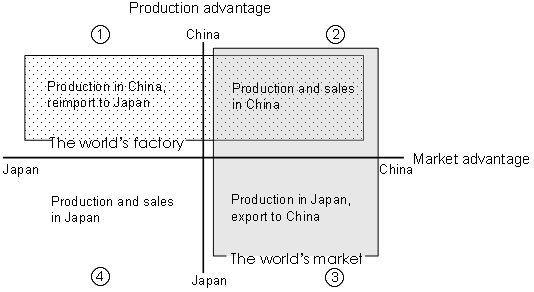The Japanese media has changed its tone regarding China's position, from "the world's factory" to "the world's market," following the nation's entry into the World Trade Organization. In line with this, Japanese firms are shifting the focus of their business with China from utilizing it as a production base for exports, to selling their products locally. However, when we consider the fact that the economies of Japan and China complement each other in many ways, there should be a variety of successful business models. Individual firms should not simply be influenced by market sentiments but plan their China business strategies by fully recognizing the strengths and weaknesses of both themselves and their partners.
When doing so, they need to ascertain whether market advantage and production advantage lie with China or with Japan. Just because wage levels in China are much lower than those in Japan does not mean that everything can be produced more cheaply there. Under the current circumstances, China does not have its own brands or technology and must depend on low wages to gain a competitive edge. In contrast, Japan still maintains strong international competitiveness in technology-intensive products. In addition, although income levels in China are rapidly rising, it is still a developing country with a per capita gross domestic product of around $1,000, and its consumption structure must be very different from that of industrialized countries. As this shows, the answer to the question of whether China is a "factory" or a "market" will differ from one industry to another.
When the issue is considered, as mapped on the axes of whether China is a factory or a market, the strategy Japanese firms should take can be divided into the following four cases (diagram). First, if China holds the advantage on the production front but Japan has the advantage on the market front, it is advisable for a company to produce its goods in China and then reimport to Japan. Second, if China holds both production and market advantage, Japanese firms should strive to manufacture their goods in China and sell them locally. Third, if China holds market advantage but Japan has production advantage, it is better to manufacture the goods in Japan and then export to China. The machinery industry, such as the automobile, falls into this category. Finally, if Japan has the advantage in both production and market, Japanese companies should focus on domestic production and sales.
Another point that should be fully acknowledged when considering business with China is that direct foreign investment and trade exist in a substitute relationship, and there are various intermediate forms between the two. In the case of direct investment, a firm can press forward with its management policy in proportion to its share of investment, but on the other hand, the risk it must take also rises. In contrast, in the case of trade, which in principle is a one-time only transaction, the accompanying risk is much smaller. Therefore, regardless of whether a company views China as a factory or a market, there are alternatives to fully putting up the capital to set up its own local subsidiaries. As in the first and second cases mentioned above, if a Japanese firm wants to utilize China as a production base, there are various options available, such as: 1) directly importing from Chinese firms; 2) signing original equipment manufacturing (OEM) contracts with Chinese companies and sell these goods under its own brand; 3) manufacturing goods through a joint venture with a Chinese company; 4) making a 100% direct investment. There are also cases such as that of Uniqlo, which has control over distribution channels, in which a firm, backed by its market advantage, can ensure that subcontractors follow its management policy without having to make capital investments. In addition, as in the second and third cases, even if a Japanese company targets the Chinese market, it must not be forgotten that local production is not the only means of access - goods can be produced in Japan and then exported to China.
As this shows, there is no need whatsoever for Japanese companies to limit themselves to the idea of "local production and local sales" when considering business with China. In order to succeed, instead of following in the footsteps of other firms in their field, companies should actively select a business model that matches their own needs so as to avoid the same mistakes made by these other firms, which are, after all, their rivals.
| Diagram : | Models of "China Business" for Japanese firms |
 | |


